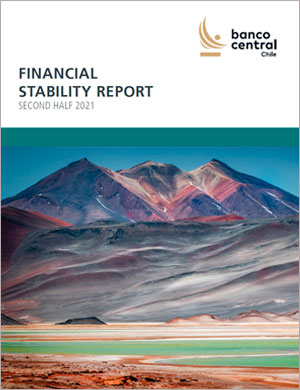Financial Stability Report Second Half 2021
Financial Stability Report Second Half 2021

Since our last Report, the global economy has continued to recover from the shock caused by the Covid-19 pandemic, thanks to two factors: progress in the management of the sanitary situation and effective economic containment policies. These policies were key to preventing the crisis from spreading to the financial markets. However, the increase in the sovereign debt and the greater exposure of the monetary authorities to the financial sector have reduced their capacity to cushion shocks in the future. In the main economies of the world, and also in Chile, the magnitude of the impulses has contributed to the economic recovery in the short term, and both users and suppliers of credit have remained resilient, with abundant liquidity availability, in a particularly challenging context. However, the persistent boost to local demand and structural changes in the capital market resulting from forced liquidations of institutional investors’ assets, have had a significant impact on asset prices. This has been compounded by the deterioration of public finances and increased uncertainty. Thus, the rise in long-term interest rates, the depreciation of the peso and the fall in stock prices have been at the extremes of international movements. This has begun to be reflected in a deterioration of the financial conditions affecting domestic agents, such as the Treasury’s financing cost, mortgage rates and terms, and the valuation of pension funds. The non-financial corporate and household sectors have seen significant cumulative amounts of capital outflows and an increased preference for dollar denominated assets. The main risk to local financial stability comes from new forced asset liquidations that continue to erode the intermediation of resources and the greater uncertainty that this implies. These developments restrict the capacity of the financial system, firms, and households to withstand corrections and/or disruptive events, which have become more likely to occur, both in the country and abroad. In the latter case, of particular note are the risks of reversal in risk perceptions, difficulties in supply chains and concerns about the Chinese real estate sector. At home, there are concerns about the possibility of a credit contraction in the face of greater risk perceptions, as well as the vulnerability of more leveraged sectors that may be affected by a deterioration of their markets.
What does this IEF tell us?

The economy has managed to recover from the recession caused by the Covid-19. The policies implemented prevented the bankruptcy of firms, and the contagion of the crisis towards the banking sector, which remains resilient.

However, the strong increase in private consumption has pushed the economy beyond its potential, fiscal accounts have deteriorated, and forced financial assets liquidations by pension funds have created a complex scenario.

The economy has managed to recover from the recession caused by the Covid-19. The policies implemented prevented the bankruptcy of firms, and the contagion of the crisis towards the banking sector, which remains resilient.
- The substantial stimulus measures, while allowing many companies to stay in business, has helped the economy to recover faster, based on a buoyant private consumption.
- Fiscal support for households increased their liquidity and made it possible to compensate for income drops, helping to keep delinquency rates in check.

However, the strong increase in private consumption has pushed the economy beyond its potential, fiscal accounts have deteriorated, and forced financial assets liquidations by pension funds have created a complex scenario.
- The reduction in the size of the intermediated funds directly affects the provision of long-term financing, which combines with other factors that have caused a deterioration in financial conditions.
- Moreover, because of high uncertainty, the demand for dollar assets has soared and capital outflows have intensified after rising since the social outbreak. These elements have eroded national savings, thus increasing the country’s dependence on external financial markets.

These factors, together with high uncertainty, have raised the exchange rate, and long-term interest rates beyond those observed in other countries, which has affected the mortgage market, and the valuation of pension funds.
- Financial conditions have worsened as a result of uncertainty and massive asset liquidations by institutional investors that are reducing the depth and adjustment capacity of the capital market.
- Both the exchange rate and local interest rates have shown strong corrections compared to other economies, accompanied by increased volatility of various asset prices.

New forced liquidations of financial assets represent a significant risk to financial stability. The Central Bank of Chile will continue to act to contain short-term volatility but cannot reverse structural changes.
- New forced liquidations of financial assets would increase uncertainty and further reduce the capacity of the fixed-income market to provide financing and cushion external shocks.
- This would further increase the cost of financing and impose greater restrictions on access to mortgage credit for individuals, investment funds for companies and government funding.
- These elements, in turn, would result in slower long-term growth. Furthermore, the derivatives market would become shallower, which would restrict foreign exchange risk management mechanisms for companies. All these elements would make the Chilean economy more vulnerable to external fluctuations and changes in global financing conditions.
Presentations
- Presidente Mario Marcel, presentación IEF segundo semestre 2021 en Comisión Hacienda del Senado
- Consejero Alberto Naudon, presentación IEF segundo semestre 2021 en Universidad Austral de Chile
- Vicepresidente Joaquín Vial, presentación IEF segundo semestre de 2021 en Pontificia Universidad Católica
- Presidente Mario Marcel, presentación IEF segundo semestre de 2021 en Asociación de Bancos e Instituciones Financieras (ABIF)
- Consejero Pablo García, presentación IEF segundo semestre de 2021 en evento organizado por el Banco Central de Chile y Coopeuch.
